As the world has both stood still and erupted on its axis, my garden has kept going. Persistent little noodge.
In the long view, several things of import have occurred. The world got warmer, while California had one of its historical droughts, so trees fell down. Then my neighborhood got hotter still. My plants needed more water in the resultant sun and heat; I ran my sprinklers more often.
Everyone in the Bay Area who grows anything other than scrub and cacti needs sprinklers.
But the additional overhead water, I’m pretty sure, brought fungus. As a result, in my front yard alone I lost a horizontal cypress, a pieris, a rosemary hedge and a climbing orange rose.
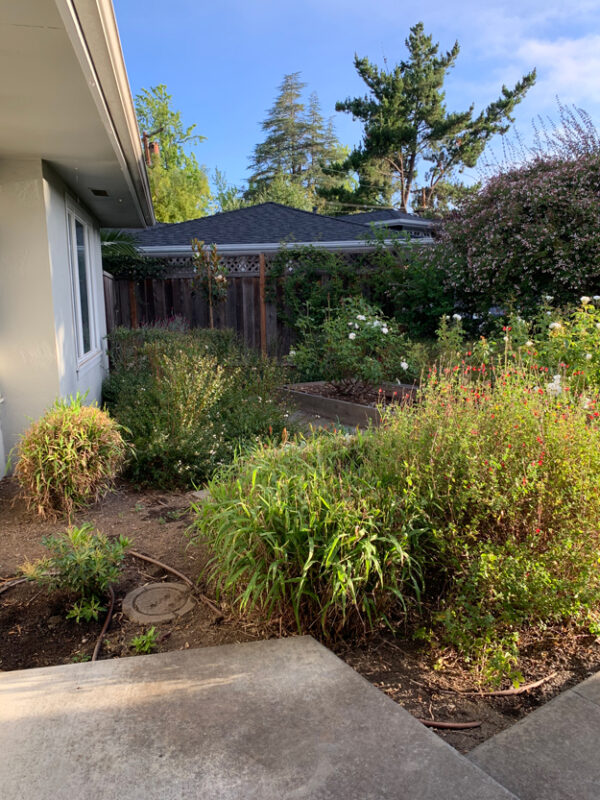
The good news is that I have finished replanting.
From my front step you can see: 1) on your left, a tiny replacement pieris 2) on your right, some short bamboo and a red salvia that hummingbirds adore 3) under the windows a growing-in miniature abelia hedge 4) along the fence a newly-planted and very etiolated magnolia tree that is somehow managing to flower and 5) a now-enormous climbing red rosebush that has lain dormant since my 40th birthday. Then a giant abelia that’s been there for what, 27 years?
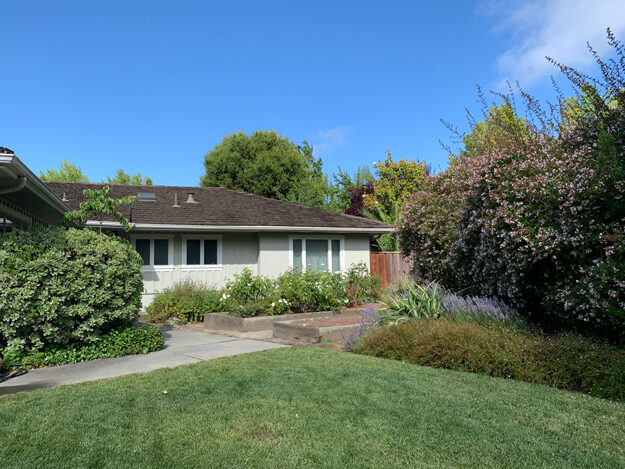
This may not look finished to you. I concede your point. After all, even when the pieris grows as tall as the windows, the abelia has been pruned into disciplined angles, and the magnolia spreads over that bit of fence, I’ll still have an empty bed up front.
But the salvia disagrees and I’m afraid she takes the day. “Done’s” in the eye of the beholder.
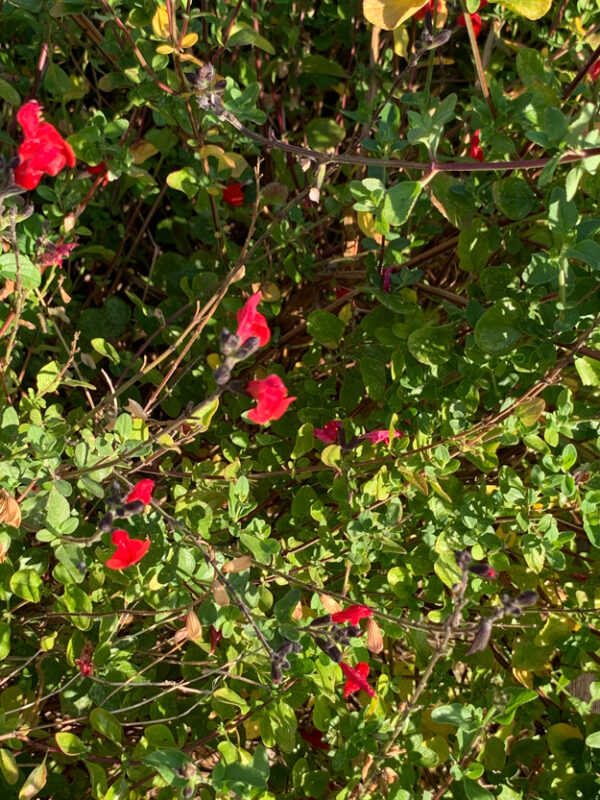
Although I suppose I could plant more white roses. Low-growing ones. Don’t get me started.
In the side yard, the California natives of what was a butterfly garden and is now a veritable resort for creepies and crawlies, have gone feral. Romantic in the morning light,
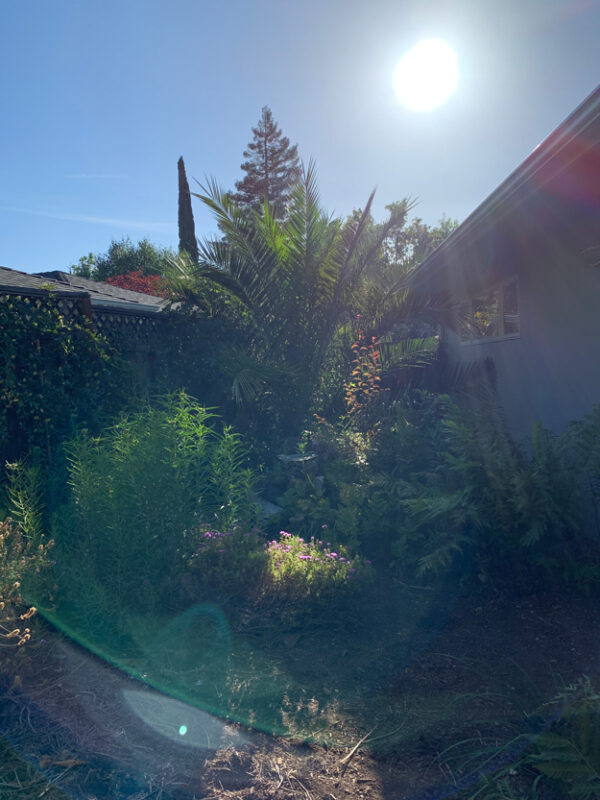
scraggly as heck as the day continues.
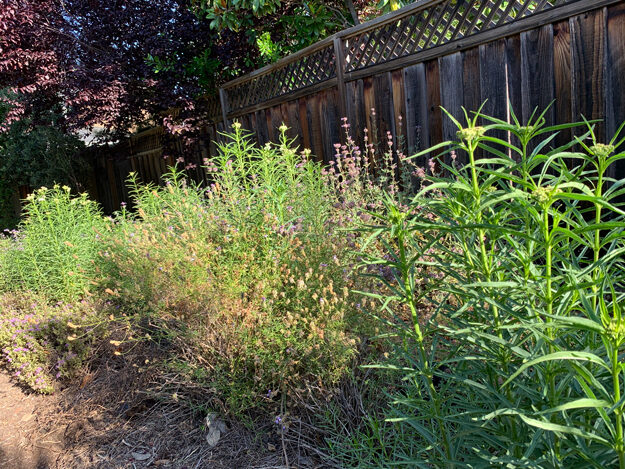
However, as crazy old ladies must, I ordered 12 Monarch caterpillars from here.
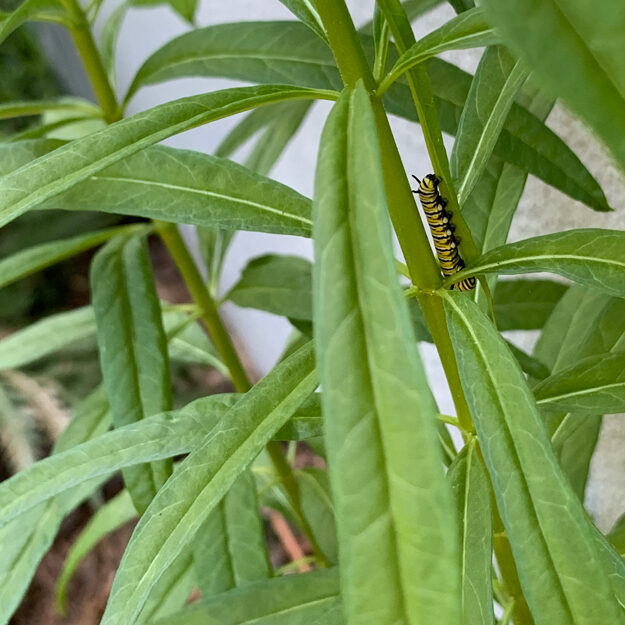
It took all of two days before I could see them no more and concluded they’d all been eaten by wasps. Then, one morning a couple of weeks later I turned around to see a full-grown Monarch perched a foot away. I had no camera, you’ll just have to trust me. She did.
They are glorious creatures, monarchs. Slow-flying, as big as your hand.
My back yard has particularly suffered under this abominable heat-sprinkler-fungus triad. While the alder I planted in the middle of the lawn thrives (and I hide under a sky blue umbrella pretending nothing is awry),
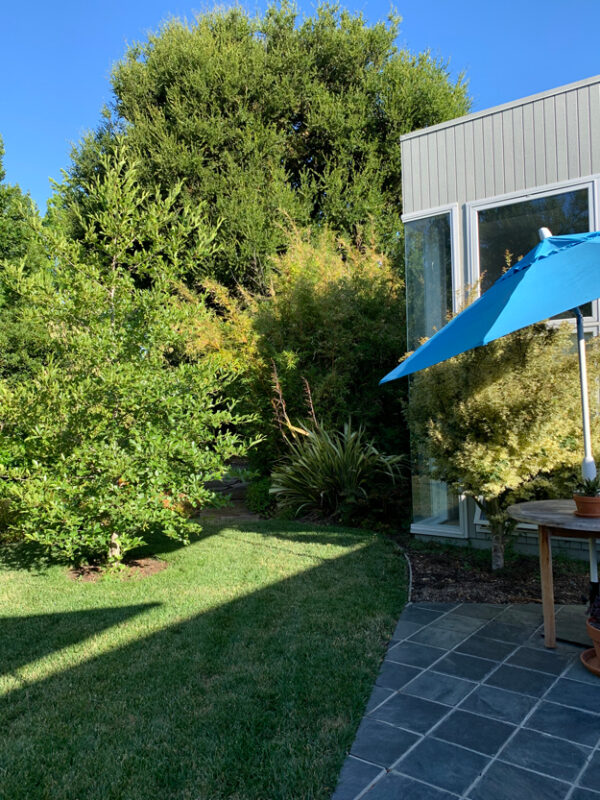
my borders are bereft. Lost a daphne. Got rid of a bunch of heavenly bamboo.
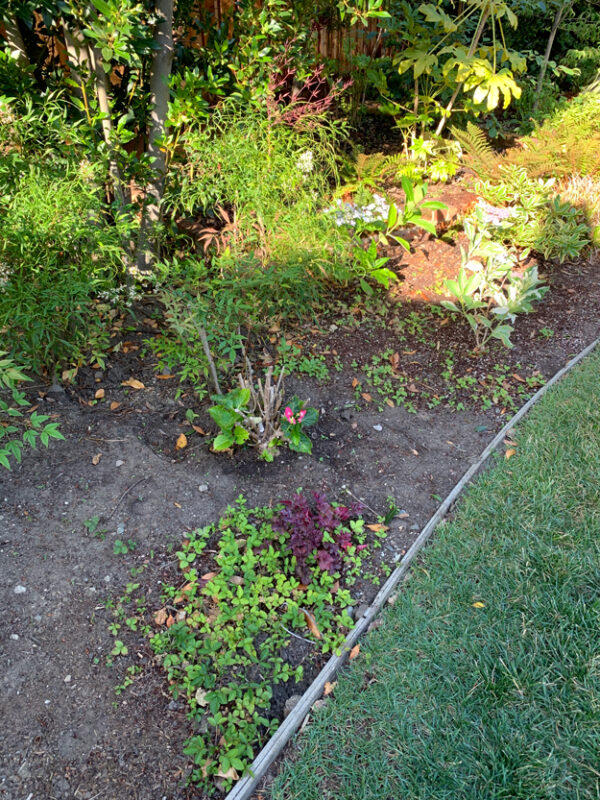
Now I am letting the area dry out a bit. It turns out that an infrastructure over time may overwater one area until it decays, and underwater another until it nearly dies. Gardens persist in metaphors.
So I’m gathering up hydrangea scraps from the rest of the yard, and transplanting them to huddle together in what shade remains. There’s hope.

Meanwhile the gardenia still blooms in her pot.
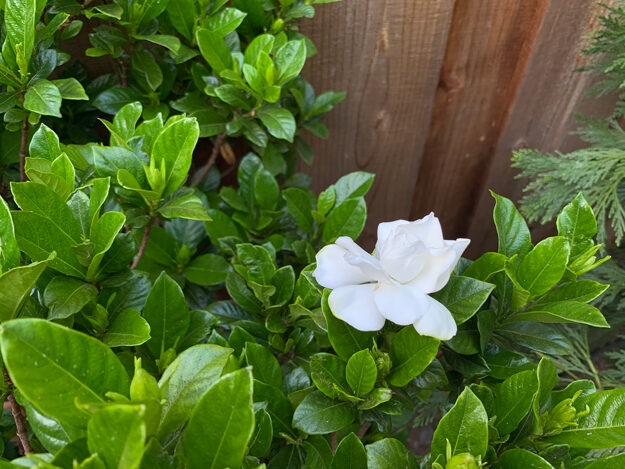
And the fuchsia, now up against the fence for shade, gives it her all.
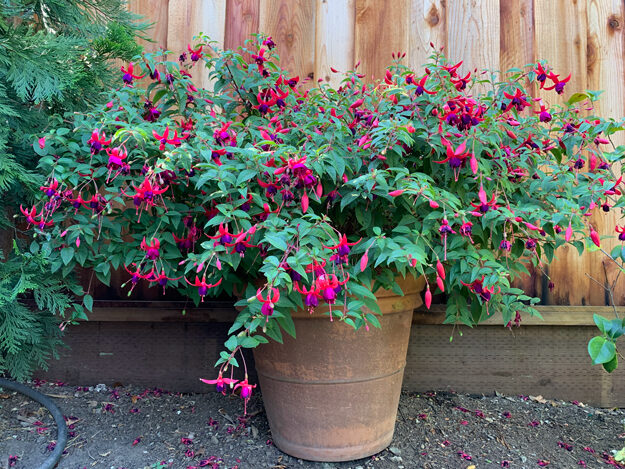
Finally, my hand-watering, especially when I move my little frog sprinkler around the lawn, draws new friends. Hummingbirds hover in the water’s arc. The other day a fritillary landed on my patio to drink, just at the edge of the irrigation.
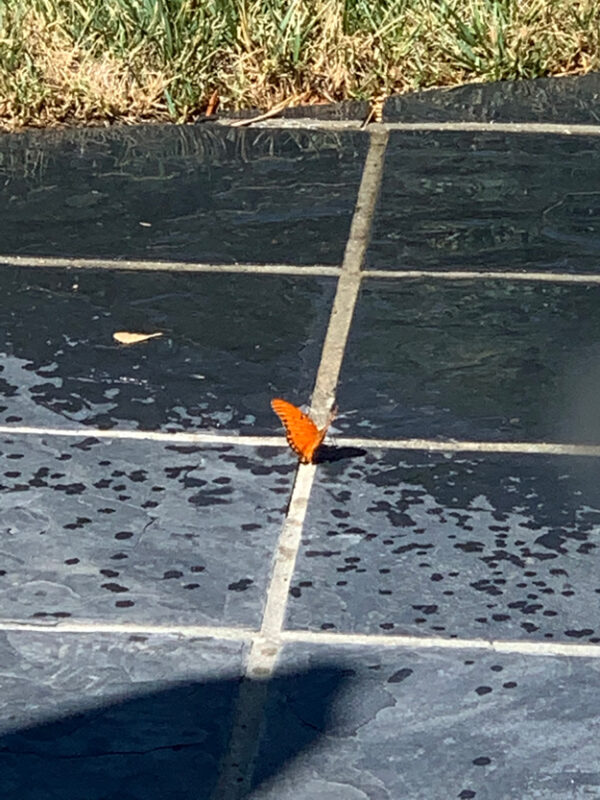
Paying attention. Have a wonderful weekend you guys.

23 Responses
We live the San Fernando Valley. I grew up here and it’s always been hot in the summer but now it’s hotter than Hades. We water the front yard twice a week for five minutes. We have roses in the side yard, plus tomatoes on drip irrigation. The front of the house (a little house with a postage stamp sized yard) has miniature roses, plus a camellia, plus a some kind of ornamental grass and a saucer magnolia. The street tree is a crepe myrtle which is supposed to be deep watered twice a month in summer. Nope. Not gonna happen. We can barely afford our water bill now. They’re all doing okay. Since the drought–the first one, not the latest one–we stopped watering our backyard altogether. Survival of the fittest! We lost the grass of course, but every other planting lives on, including a grapefruit tree that must produce hundreds of fruits, all year. No water. No fertilizer. Just whatever Mother Nature supplies. Replacing the dead grass with drought-resistant plants is low on my priority list. It will get done, eventually, maybe, if I live long enough…
@Wendelah, I admire your commitment to low-water gardening. My house faces south and as of yet we have no air conditioning. So I water to grow trees in hopes of shade. But I may have to move to a full xeriscape in a couple of years, lots of hardscaping and natives and succulents:(
I enjoyed this tour of your garden and all the underlying lessons.
@Susan D., Thank you:).
Many years ago, I did an excellent gardening course with an Englishwoman then resident in Princeton. Almost the only thing I remember now is her saying, “A gardener lives on hope.”
That’s become my mantra whenever I face the magical combination of seed (or root) and soil.
PS: Thanks for the tour of your own garden(s) – whether reflecting hopes fulfilled or hopes dashed!
A sweet tour of your garden — always rich in metaphors, they are, and for those who can care for one as long as you have, a fascinating record of what time can do with space. . . Have to admit you startled me, for a moment, with the fritillary coming to drink. I always think of the fritillary as bulb/flower, and I had to guess (okay, yes, helped by your photo) that there’s a butterfly that shares the name.
Yay! for the monarch-hatching, btw. . .
Your garden represents a lot of work, a lot of hope. My hat is off to you!
Such a lovely assortment of plants, although the work you’re putting in must be enormous I have never seen such a lovely fuchsia here on the East Coast. Perhaps the garden thrives on hope, but you must have enormous skill to have developed such a marvelous yard.
It’s wonderful to see all these plants that I don’t know at all. Plus I learned a new word: etiolated. Thanks for the tour!
Thank you SO much. And yes, I do believe monarch caterpillars VANISH for a few days, as part of their becoming!!! And I’m so hopeful and impressed with your hydrangea all clumped and cooled together.
Gardens and weather are the boss of us, a reminder of our plans always butting up against impermanence and alteration. Your changes are beautiful, as is your sipping fritillary, which reminds me of Paul Henreid commenting on the fritillary pattern on Bette Davis’s cape in Now Voyager. Fritillary sounds extra-beautiful in Henreid’s accent. Yesterday, ate outside at Mayfield Cafe to honor Juneteenth, and shopped inside Books Inc,, masked and in a limited group. Was astonished at the T&C crowds. Alameda County and Santa Clara County are opening up differently. I wonder if you in San Mateo are similar to Santa Clara. It was my first restaurant meal since 14 March, and a pleasure on a beautiful day. Happy Saturday.
Our front “yard” is all a variety of drought resistant plants and decomposed granite. Our backyard is a sort of L shape, and on the non-pool side, in the process of planting fruit tress. Around the pool area is all hardscape (can you tell I wanted very low maintenance?) I’ll have some half wine barrels with I’m not sure what yet.
Your garden is lovely and wild in a nice way. Have you ever had any desire to plant vegetables or have a citrus tree? I’m planting some herbs in a planter on the courtyard off the kitchen – I find I use them all the time if I have them…but I don’t have a green thumb, at all.
Lisa, as I have told you I am not a gardener. Perhaps, too much life and death for me. Your garden grows dear Lisa and what a sanctuary it is from all the chaos.
It is must be hard letting go and starting again yet, you have created a refuge for your family and the animals.
Luci
Very pretty and natural looking. Nothing fussy. My kind of place. Take time to enjoy it this weekend, and beyond.
Gardens are such a gift.
You have such a beautiful garden, thanks for sharing it with us.
The garden is truly a labor of love. The heat and no rain is definitely challenging us this year. Your monarch butterfly must have been beautiful. Hopefully the monarch has taken up residence in your garden. Thank you for the tour.
I am SO inept with plants, but looking at your lovely gardens, I have an inkling of hope. Thanks, Lisa!
What a lovely post. I wish one day I could have a garden just like yours. Thank you, Lisa. <3
Thank you for reminding me that there is beauty right outside our door.
Love the garden photos. Your garden posts always make me inordinately happy and this one is no exception. It seems pregnant with hope and a wonderful meeting of planning and wild impermanence. It must bring you great joy. And now, as I have just come in from digging a new bed and planting, I must go shower and stare out the window at my newly planted babies, letting my hopes and dreams for them fly.
What a beautiful post! And I love seeing pics of your garden!!
Old stagers here on Earth’s second driest continent (after Antarctica) have a saying – “roses love a drought”. Indeed they do! They manage without a drop and then flower like a thing possessed at the first flush of rain.
Which is to say – planting more white roses sounds like an excellent plan!
You may also find many of our natives do brilliantly in your climate, all the more so as it changes. We have more than the ubiquitous weedy eucalyptus – a veritable cornucopia of flowers and shrubs and trees that are as pretty as they come and as tough as old boots.
Most of my 1 acre garden area doesn’t get watered at all – and none of the rest of the property does. Yet even with a summer that was 4 C above average and topped 44 C, so much survived. And now of course, with a planetary act of grace in the form of some beautiful rain, everything has gone bonkers.
Grevilleas, hakeas, callistemons, Correas, myoporum, banksia, leptospermum, acacias, philothecas – they produce masses of flowers and pollen for birds and insects staggered throughout the whole year, and really require no watering at all. Just a thought!